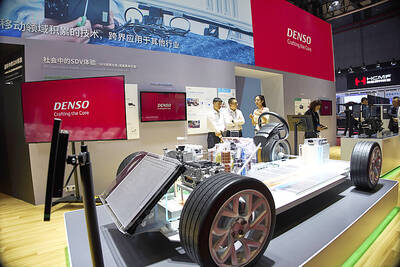The nation’s exports of passive components — including resistors, capacitors and inductors — grew by a double-digit percentage for the second straight year last year to reach US$2.58 billion, the highest since 2003, the Ministry of Economic Affairs said on Friday last week.
Overseas sales of Taiwan’s passive components were still lower than those from Japan, which rose 11 percent year-on-year to US$7.02 billion last year, but were higher than South Korea’s US$1.87 billion, which grew 25.9 percent from a year earlier, the ministry said.
“Japan remains the world’s top exporter of passive components, as it has the upper hand when it comes to the supply of raw materials and equipment needed to produce such electronic components,” the ministry said in a statement on its Web site.
In the past few years, leading Japanese manufacturers have continued to develop advanced technologies and shifted their focus to high-end products, it said.
Passive components are the basic building blocks of electronic circuits. They are used in a wide range of electronic devices, such as computers, mobile phones, servers, automotive electronics, and communications and networking products.
Due to the global economic slowdown in 2012, which negatively affected end-market demand and caused a supply-demand imbalance, Taiwan’s exports of passive components contracted by 5.7 percent annually that year and registered four consecutive years of negative growth through 2015.
However, growing demand for passive components as mobile devices became increasingly sophisticated and a wider adoption of semiconductors in automotive electronics resulted in Taiwanese exports recording an annual increase of 29.7 percent in 2016.
Last year, exports of passive components rose 13.1 percent year-on-year, with capacitors accounting for 57.9 percent of the total shipments, resistors contributing 23.6 percent and inductors making up 18.5 percent, the ministry said.
The export growth showed no sign of a slowdown in the first five months of this year, with outbound shipments expanding 27.2 percent from the same period last year, it said.
China, including Hong Kong, continued to be the largest destination for Taiwanese exports, accounting for 79.2 percent of overall outbound shipments, while exports to the US accounted for 4.3 percent and shipments to Germany made up 3.3 percent, it said.
In China, Japanese imports held the largest market share of 41.1 percent last year, followed by Taiwanese goods at 11.9 percent and imports from the Philippines at 8.2 percent, the ministry said.

GROWING OWINGS: While Luxembourg and China swapped the top three spots, the US continued to be the largest exposure for Taiwan for the 41st consecutive quarter The US remained the largest debtor nation to Taiwan’s banking sector for the 41st consecutive quarter at the end of September, after local banks’ exposure to the US market rose more than 2 percent from three months earlier, the central bank said. Exposure to the US increased to US$198.896 billion, up US$4.026 billion, or 2.07 percent, from US$194.87 billion in the previous quarter, data released by the central bank showed on Friday. Of the increase, about US$1.4 billion came from banks’ investments in securitized products and interbank loans in the US, while another US$2.6 billion stemmed from trust assets, including mutual funds,

Micron Memory Taiwan Co (台灣美光), a subsidiary of US memorychip maker Micron Technology Inc, has been granted a NT$4.7 billion (US$149.5 million) subsidy under the Ministry of Economic Affairs A+ Corporate Innovation and R&D Enhancement program, the ministry said yesterday. The US memorychip maker’s program aims to back the development of high-performance and high-bandwidth memory chips with a total budget of NT$11.75 billion, the ministry said. Aside from the government funding, Micron is to inject the remaining investment of NT$7.06 billion as the company applied to participate the government’s Global Innovation Partnership Program to deepen technology cooperation, a ministry official told the

Taiwan Semiconductor Manufacturing Co (TSMC, 台積電), the world’s leading advanced chipmaker, officially began volume production of its 2-nanometer chips in the fourth quarter of this year, according to a recent update on the company’s Web site. The low-key announcement confirms that TSMC, the go-to chipmaker for artificial intelligence (AI) hardware providers Nvidia Corp and iPhone maker Apple Inc, met its original roadmap for the next-generation technology. Production is currently centered at Fab 22 in Kaohsiung, utilizing the company’s first-generation nanosheet transistor technology. The new architecture achieves “full-node strides in performance and power consumption,” TSMC said. The company described the 2nm process as

JOINT EFFORTS: MediaTek would partner with Denso to develop custom chips to support the car-part specialist company’s driver-assist systems in an expanding market MediaTek Inc (聯發科), the world’s largest mobile phone chip designer, yesterday said it is working closely with Japan’s Denso Corp to build a custom automotive system-on-chip (SoC) solution tailored for advanced driver-assistance systems and cockpit systems, adding another customer to its new application-specific IC (ASIC) business. This effort merges Denso’s automotive-grade safety expertise and deep vehicle integration with MediaTek’s technologies cultivated through the development of Media- Tek’s Dimensity AX, leveraging efficient, high-performance SoCs and artificial intelligence (AI) capabilities to offer a scalable, production-ready platform for next-generation driver assistance, the company said in a statement yesterday. “Through this collaboration, we are bringing two